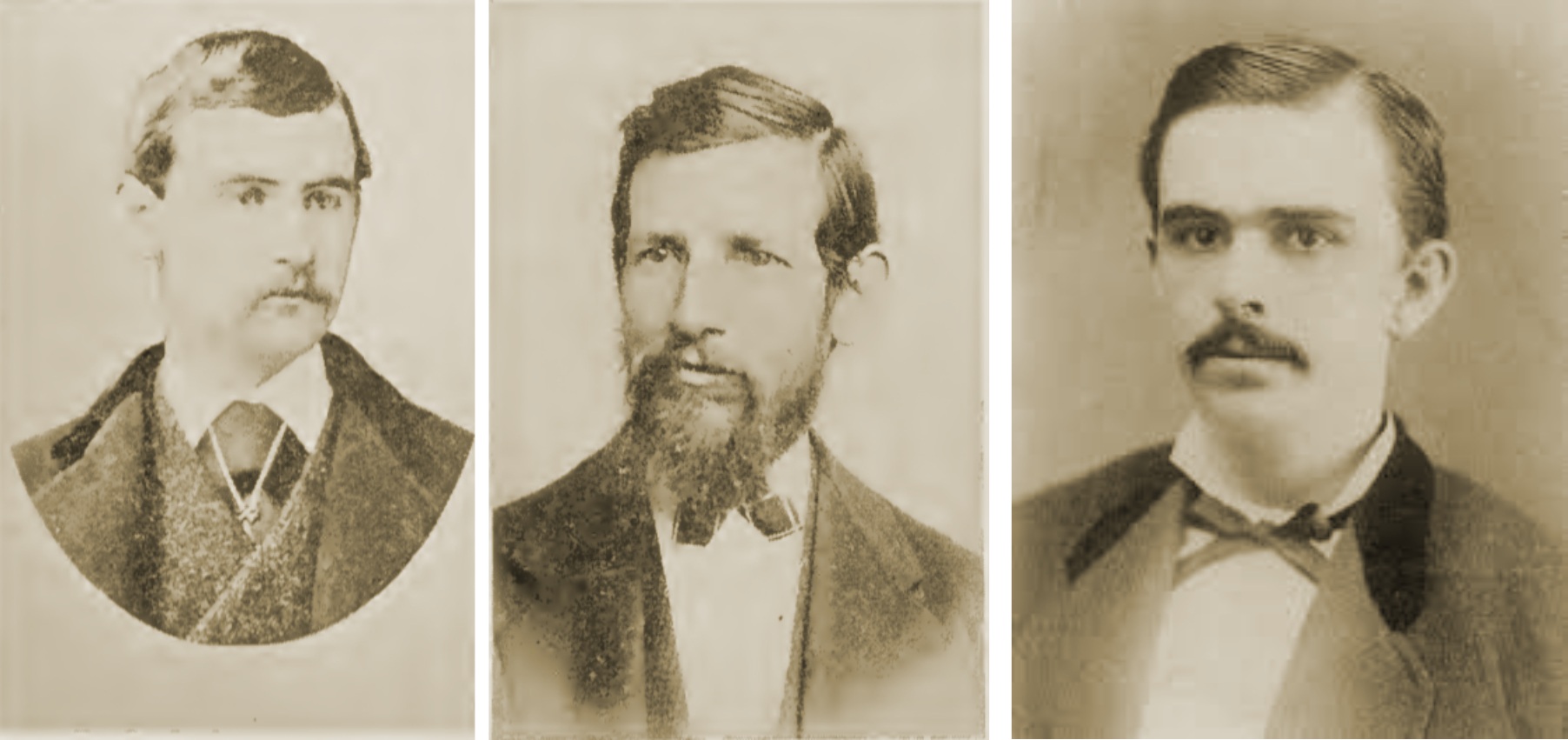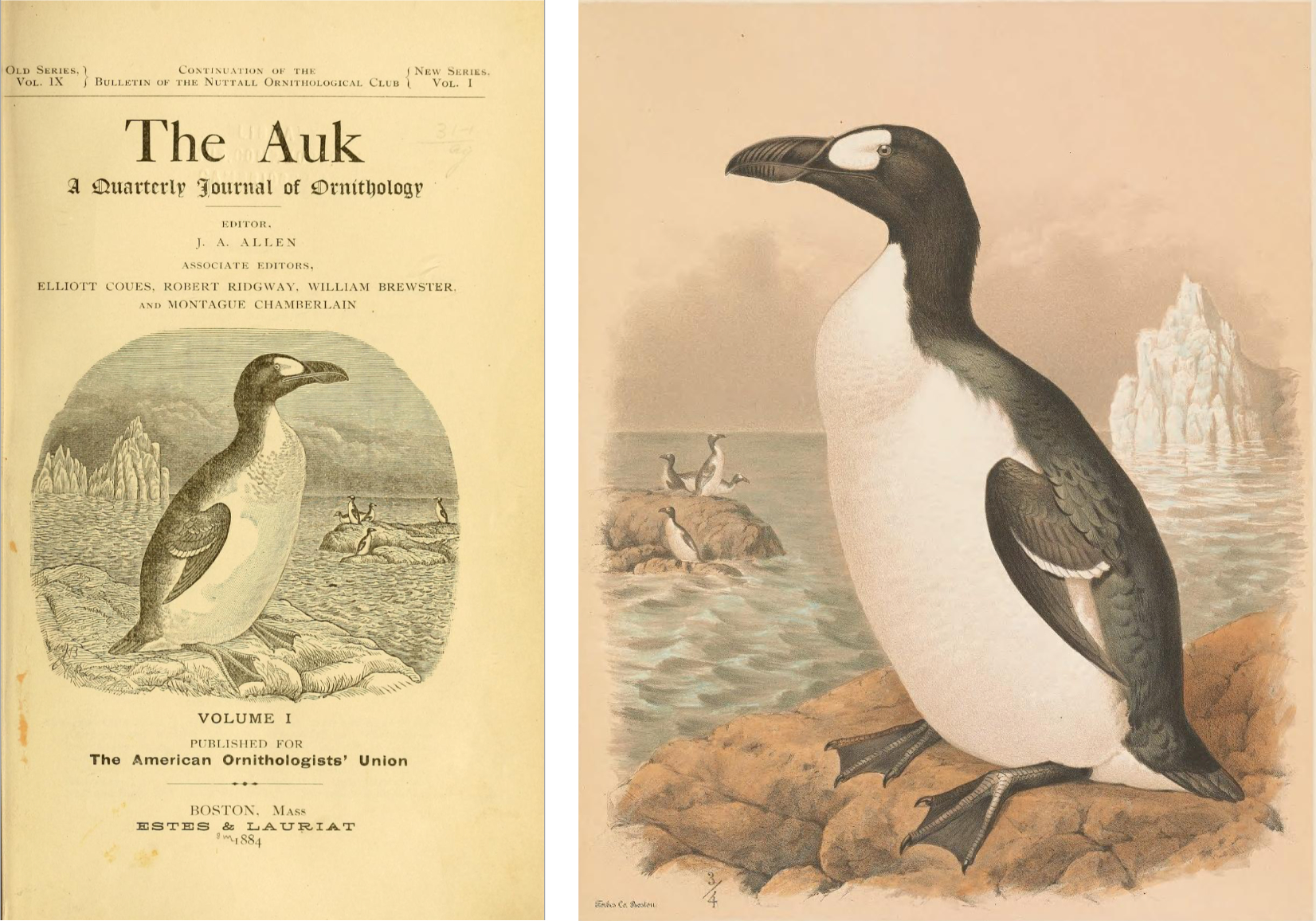
On the first of August 1883, three young members of the tiny [1] Nuttall Ornithological Club (NOC) of Cambridge, Massachusetts—the President (William Brewster), as well as the Editor (Joel Asaph Allen) and the Associate Editor (Elliott Coues) of its Bulletin planted the seed that would grow into the AOU. All three were in their twenties at the time but would before long lead the scientific study of birds in North America.
To plant that seed, they sent a letter to 48 prominent North American ornithologists inviting them to a Convention in New York City in late September “for the purpose of founding the AMERICAN ORNITHOLOGISTS UNION upon a basis similar to that of the “British Ornithologists’ Union” “[2]. At that convention:
…the question of an organ, in the form of a serial publication, was the first to present itself, and the impression was general that such a publication must prove indispensable to the work of the Union. It was accordingly voted to establish such a journal, its publication to begin January, 1884. Mr. Allen was chosen editor, to be assisted by a staff of associate-editors, likewise selected by the Council, who are collectively to decide the character of the periodical, and to whom will be intrusted its management…it became a question with the members of the Nuttall Ornithological Club whether the Nuttall Club should continue to publish an organ, which, under the new conditions, could only be a rival of that of the Union…the Nuttall Club, at a meeting held October 1, voted to discontinue its Bulletin with the close of the present volume, and to offer to the American Ornithologists’ Union its good will and subscription list…with the tacit understanding that the new serial of the Union shall be ostensibly a second series of the Nuttall Bulletin. It is therefore to be hoped and expected that the many friends of the Bulletin who have hitherto given it such hearty support will extend their allegiance to the new publication of the Union, freely contribute their observations to its pages, and use their influence to extend its usefulness. [3]
 And thus, in 1883, the AOU, and its journal, The Auk, were born—more by C-section than natural birth [4]—from the NOC and its journal . The NOC was the first scientific society (1873) devoted to ornithology in North America and its Bulletin (1876) the first ornithological journal in the USA. While we know when, how, and why the AOU and its journal were founded, the reasons for the AOU naming its journal ‘The Auk‘ and the origin of the line drawing on its cover are more mysterious.
And thus, in 1883, the AOU, and its journal, The Auk, were born—more by C-section than natural birth [4]—from the NOC and its journal . The NOC was the first scientific society (1873) devoted to ornithology in North America and its Bulletin (1876) the first ornithological journal in the USA. While we know when, how, and why the AOU and its journal were founded, the reasons for the AOU naming its journal ‘The Auk‘ and the origin of the line drawing on its cover are more mysterious.
As the short quotation above indicates, the AOU was patterned after the BOU (established in 1858), so it seems likely that the founders of the AOU wanted to name their journal after a bird, much as the BOU had done with The Ibis. But why ‘The Auk‘ and why the Great Auk on the cover?
The first editors simply claimed that: The outcry from all quarters excepting headquarters of American ornithological science against the name of our new journal satisfies us that the best possible name is The Auk [5]. And they go on to make several whimsical suggestions [6] for the choice of that name. I suspect, however, that the name was chosen simply because The Auk‘s first editor, Joel Asaph Allen, had great interest in this species, having published a note on their extinction in The American Naturalist in 1876. Like the Sacred Ibis that inspired the naming of The Ibis, the Great Auk was very much in the public eye in 1880, being the first North American bird clearly driven to extinction [7] by man, as recently as 1844.
Allen was also a friend of Charles Barney Cory, who lived in Boston and joined the NOC in 1876, when he was only 19. Cory was later one of the ipso facto founders of the AOU [8], one of the 26 men who attended that first conference in New York. In 1880, Cory began publishing his Beautiful and Curious Birds of the World, a large format work that was to appear in 12 Parts at about 3 month intervals, with each Part dealing with 2-3 species that Cory were most beautiful and curious. Each species account comprised both a hand coloured full-page (21″ x 27″) lithograph and 2-3 pages of text. Joseph Smit did the artwork, and the book was limited to 200 copies and could be obtained only by subscription.
In 1880, Allen reviewed Part 2 of Cory’s work in the Bulletin of the Nuttall Ornithological Club and said, of the Great Auk, that “the general execution of this plate is both spirited and artistic while the coloring is quite beyond criticism” [9]. Clearly, he was a fan of the book and the bird. That plate, or possibly the original painting, was used as the basis for the line drawing that appeared on the first volume of The Auk, shown below. Notice that in addition to pointing the bird the other way, The Auk cover shows a wider scene but the rest is identical.

In October 1973, a century after the founding of the Nuttall Club, the NOC presented to the AOU one of the original Great Auk plates [10] from Cory’s publication, in recognition of their shared history. That framed print is handed down from editor-in-chief to editor-in-chief of The Auk, and after 45 years was showing the mileage of its travels and its exposure to light and moisture. This year, the AOS is having this original print reframed and restored to ensure that it will continue to grace the offices of the journal’s editors-in-chief. Alan Brush (editor from 1984-92) recently donated to the AOS another beautifully framed Great Auk plate from the Cory book, which now hangs in the AOS executive office.
That first cover design served The Auk well for 30 years but was then replaced by an original drawing by Louis Agassiz Fuertes in 1913, then again by him in 1915 to match more closely the look of the original. That 1915 Great Auk by Fuertes has adorned the cover, with slight alterations, ever since:

SOURCES
- Allen JA (1880) Recent Literature: Cory’s “Beautiful and Curious Birds of the World.” Bulletin of the Nuttall Ornithological Club 6: 111
- Allen JA, Coues E, Brewster W (1883) The American Ornithologists’ Union. Bulletin of the Nuttall Ornithological Club 8: 221-226
- Anonymous (1884) Notes and News. The Auk 1: 105
- Batchelder CF (1937) An account of the Nuttall Ornithological Club 1873 To 1919. Memoirs of the Nuttall Ornithological Club 8: 1-109
- Bengston S-A (1984) Breeding ecology and extinction of the Great Auk (Pinguinus impennis): anecdotal evidence conjectures. The Auk 101: 1-12
- Cory CB (1880-1883) Beautiful and Curious Birds of the World. Boston: published by the author for the subscribers
Footnotes
- members of the tiny NOC: the NOC was founded in November 1873 by 8 young men. The nucleus of that group was 4 former high school friends (including Brewster) who had been meeting each Monday for a couple of years to read Audubon and talk about birds. By 1883 the membership had grown to 15 (Batchelder 1937).
- quotation from letter to ornithologists: from Allen et al. 1883 page 221
- quotation about the AOU’s journal: from Anonymous 1884 page 105
- born by C-section: according to Batchelder (1937), Allen, Coues and Brewster acted on their own to found the AOU, using their NOC positions to establish some credibility. They did not, apparently, inform the other NOC members of their actions or their intention to transform the Bulletin into the Auk
- quotation about the best possible name: from Anonymous 1884 page 105
- whimsical suggestions: this rather long quotation, from page 105 in Anonymous 1884, is reproduced below
- first North American bird driven to extinction: the Labrador Duck was probably extinct by 1880 but it was always rare and it was not clear that humans had caused their extinction; the Passenger Pigeon and Carolina Parakeet were still extant in the 1880s and were not extinct until early in the 20th century
- ipso facto founders of the AOU: as Allen et al. (1883, page 221) said in their report on the conference— Those who attend the first meeting will be considered ipso facto Founders of the American Ornithologists’ Union
- quotation from the review of Cory’s Part 2: from Allen 1880 page 111
- original Great Auk plate: see Bengston (1984). Cory’s publication is now for sale at auction for $30,000. Since only 200 were made, and the original lithographs destroyed, this is one of the rarest of 19th century works on birds
whimsical suggestions (see footnote 6):
Were the name of this journal one which anyone could have proposed and everyone liked, it could not have been an ‘inspiration.’ The editors beg to say that they have copyrighted, patented, and ‘called in’ the following puns and pleasantries: I. That The Auk is an awkward name. 2. That this journal is the awk-ward organ of the A. O. U. (These two species, with all possible subspecies, for sale cheap at this office.) 3. That this journal should be published in New Yauk. or in the Orkney or Auckland Islands. (It is published at Boston, Mass.. at $3.00 per annum, — free to active members of the A. O. U. not in arrears for dues.) 4. That an Auk is the trade-mark of a brand of guano. (A rose by any other name, etc. ) 5. That the Auk is already defunct, and The Auk likely to follow suit. (Mortua Alca impeninis — in pennis ALCA rediviva!) 6. That the Auk couldn’t fly, and what’s the use of picking out a name. etc.. etc. (But the Auk could dive deeper and come up drier than any other bird, as Baird says.) 7. That The Auk apes ‘The Ibis.’ (Not at all. It is a great improvement on ‘Ibis.’ ‘Ibis’ is two syllables and four letters; ‘Auk’ is only one syllable and three letters — a fact which bibliographers will appreciate. It is simply following a good precedent because it is good. We wish, however, that we could ‘ape’ or otherwise imitate ‘The Ibis’ in sundry particulars. We should like to make THE AUK the leading ornithological journal of America, as ‘The Ibis’ is of the rest of the world. We should like to make THE AUK the recognized medium of communication between all the ornithologists of this country’, as ‘The Ibis’ is of that. We should like to take and keep the same high standard of excellence in every respect, and thus become such an acknowledged authority as ‘The Ibis’ is. We should like, on behalf of the A. O. U.. to imitate ‘The Ibis’ in the courtesy and kindliness already shown us on the part of the B. O. U. We should like to ‘ape’ or otherwise resemble ‘The Ibis’ in vitality and longevity. May its shadow, already’ ‘sacred,’ be cast while the pyramids stand ; and may THE AUK in due time be also known of men as an “antient and honourable foule” !)